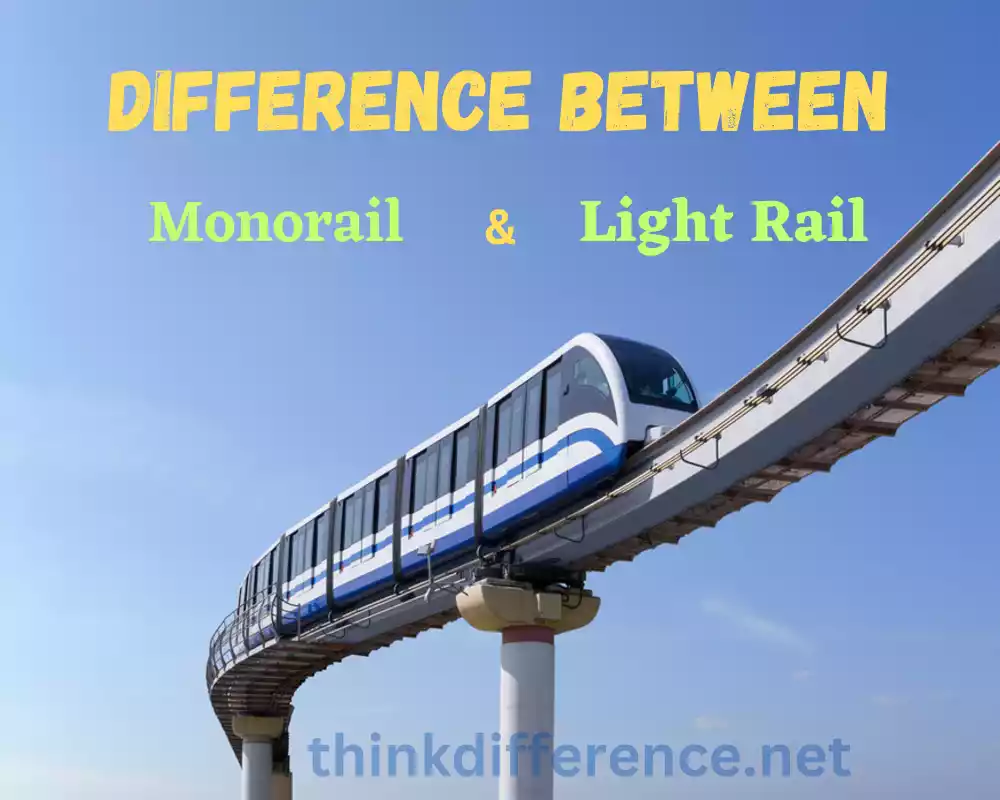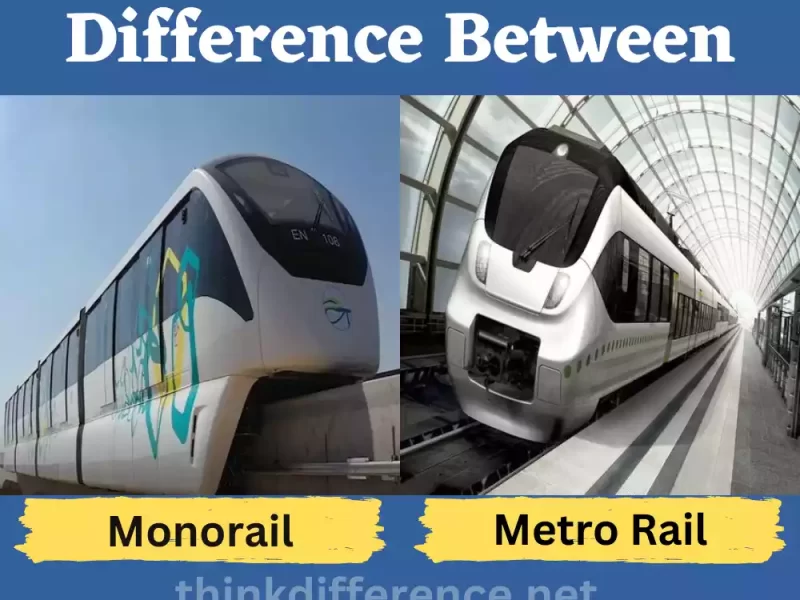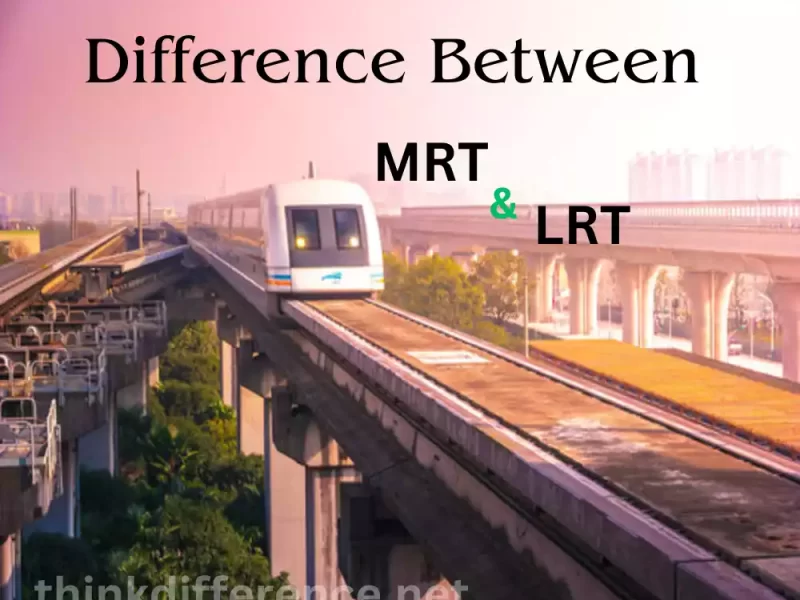Monorail and Light Rail systems have emerged as viable ways of relieving traffic congestion, cutting pollution levels and improving mobility. Both systems aim to transport large populations efficiently while offering differing capacities of infrastructure support, capacity utilization and application options.
What is Monorail?
Monorail transportation systems use single rail tracks typically elevated above ground on which vehicles or trains travel, as compared with traditional railroad systems with two parallel tracks running parallel. Monorail systems typically feature only one beam or guideway which supports trains. They’re known for their distinctive, innovative designs usually featuring sleek modern aesthetics.
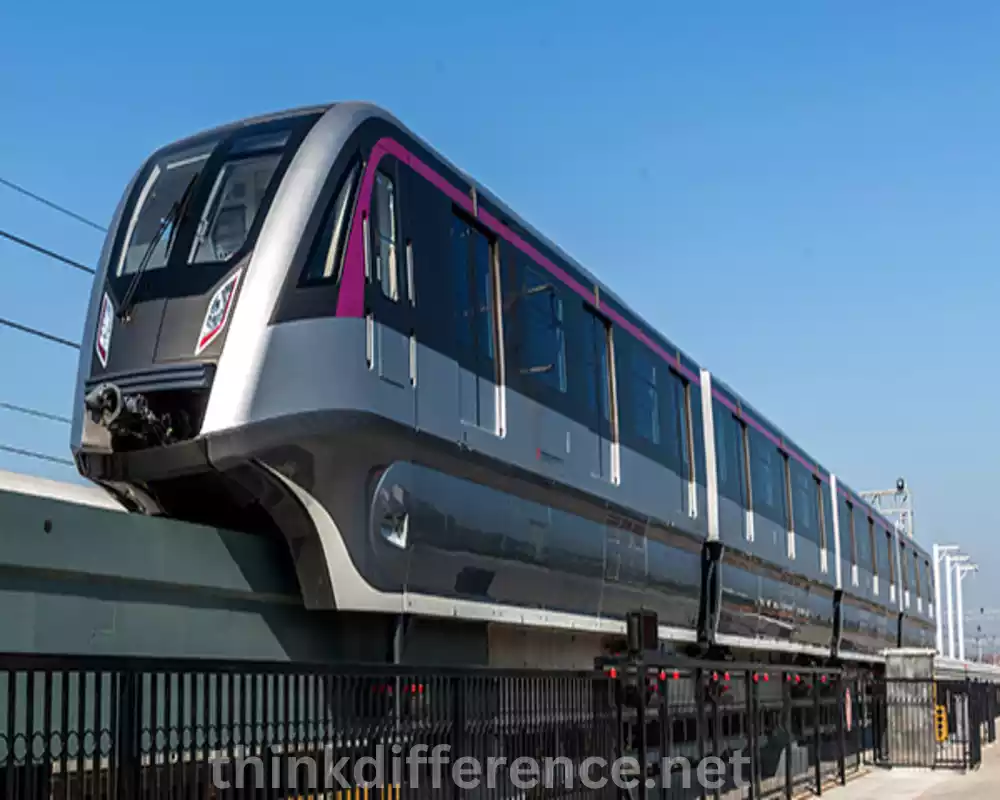
Here are some key characteristics of monorail systems:
- Infrastructure and track system: Monorails typically operate on elevated tracks, which can be supported by columns or beams. Single rail tracks can be made out of various materials like concrete, steel and composites.
- Rolling stock and vehicles: Monorail trains are specially designed to run on the single rail track. These trains often feature a unique wheel arrangement, such as rubber tires or guide wheels, which provide stability and guidance along the monorail beam.
- Capacity and passenger handling: Monorail systems can vary in terms of passenger capacity. They can range from smaller trains carrying a few dozen passengers to larger trains accommodating several hundred passengers. The trains usually have multiple doors for efficient boarding and alighting and they can be configured with both seated and standing areas.
- Advantages of monorail: Monorail systems offer several advantages, including reduced noise and vibration due to the elevated track and specialized train design. They can achieve higher potential speeds compared to traditional light rail systems, making them suitable for longer distances or connections between major transportation hubs. Monorails are often considered aesthetically pleasing and can add a unique architectural element to urban landscapes.
- Safety and reliability: Monorail systems are constructed to maximize security. The elevated track minimizes the risk of accidents or collisions with other vehicles or pedestrians. Monorail trains feature advanced safety features, such as emergency braking systems and redundant control systems to protect passengers.
- Use cases and applications: Monorail systems can be implemented in various settings, such as urban areas, airports, theme parks and tourist destinations. Motorways provide transportation solutions along specific corridors or to connect different parts of a city.
Be mindful that although monorails offer certain advantages, they might not always be appropriate for every transportation need. Considerations must include cost infrastructure costs as well as urban planning issues when making this determination.
What is Light Rail?
Light rail transit refers to any form of suburban or urban rail transport operated by electric-powered light vehicles running along tracks installed near streets in cities. Light rail was created as an answer for medium capacity transport needs that balance between large rail systems such as subways and mobility of bus transport services, providing medium capacity solutions suitable for highly urban regions. Light rail systems offer public transit solutions by increasing mobility without impacting service quality as much as the alternative options may.
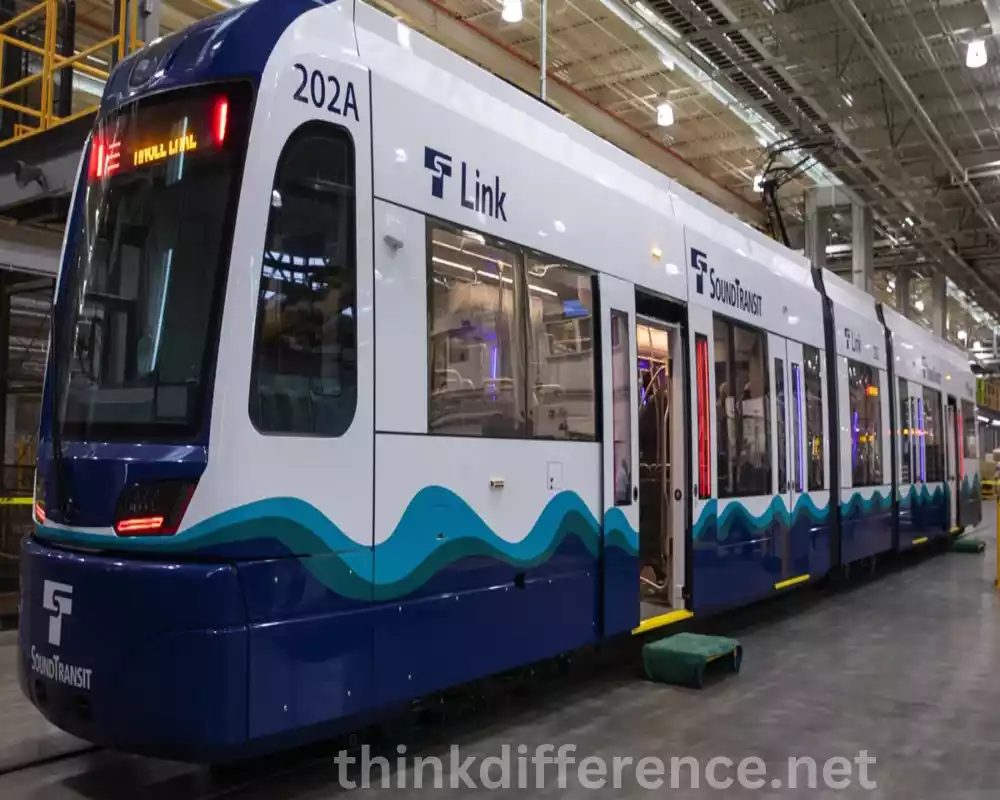
Characteristics of light rail systems include:
- Infrastructure and track system: Light rail typically operates on tracks that are laid on or along existing streets, although some sections may have their own dedicated rights-of-way. The tracks are often integrated with the urban environment, sharing space with other road users.
- Rolling stock and vehicles: Light rail vehicles are electrically powered and are usually lighter and smaller in size compared to heavy rail trains. They can be designed as single cars or multiple-car trains, depending on the capacity requirements of the system.
- Stations and stops: Light rail systems have designated stations or stops along their routes, typically placed at regular intervals. These stations often have platforms that are at the same level as the train floor, making boarding and alighting convenient for passengers.
- Capacity and passenger handling: Light rail systems can carry a moderate number of passengers, ranging from a few hundred to a few thousand per train. The vehicles usually have multiple doors for efficient boarding and alighting, and they can accommodate both seated and standing passengers.
- Integration with the urban environment: Light rail systems are designed to blend with the existing urban landscape. They can be integrated with streets, pedestrian areas and other modes of transportation, allowing for easy transfers and access to key destinations.
- Cost considerations: Compared to heavy rail systems, light rail construction and operation costs are generally lower. Light rail tracks don’t cost nearly as much to construct and their cars require far less upkeep and care than their conventional counterparts. This makes light rail an attractive option for cities looking to expand their public transportation network while managing costs.
- Environmental benefits: Light rail is considered a sustainable mode of transportation since it operates on electricity and produces lower emissions compared to vehicles powered by fossil fuels. Reduce traffic congestion, enhance air quality and create an environmentally sustainable urban setting are among the many potential advantages.
Light rail systems can vary in their specific design and features depending on the city and its transportation needs. Public transit provides commuters with reliable transport alternatives that reduce dependence on private cars while encouraging sustainable mobility in urban environments.
Importance of understanding the difference between Monorail and Light Rail
Understanding the difference between light rail and monorail systems is crucial for many reasons; in particular, to maintain safe operations.
- Transportation planning: Having a clear understanding of the distinctions between monorail and light rail systems helps urban planners, policymakers and transportation authorities make informed decisions when developing or expanding public transportation networks. It allows them to assess the suitability of each system for specific corridors, passenger demands, and budget constraints, leading to more effective and efficient transportation planning.
- Cost considerations: Monorail and light rail costs vary considerably in cost for construction, operation, maintenance and operation, providing individuals a much clearer picture of how these two options impact their finances in detail. Knowing their differences allows individuals to assess each decision with greater accuracy. This helps allocate resources appropriately and ensure cost-effective investments in public transportation infrastructure.
- Infrastructure requirements: Monorail and light rail systems have different infrastructure requirements. Monorails typically require dedicated guideways or elevated tracks, while light rail systems can operate on existing streets or have their own dedicated right-of-way. Understanding these infrastructure needs helps determine the feasibility and impact of implementing each system in a particular urban environment.
- Passenger experience: The passenger experience can differ between monorail and light rail systems. Factors such as capacity, comfort, accessibility and travel time can vary between the two. Understanding these differences helps transportation planners and operators design systems that meet the needs and expectations of passengers, ensuring a positive and convenient travel experience.
- Integration with existing infrastructure: Transportation systems need to integrate seamlessly with existing infrastructure like railways and roads as well as public transit options. Understanding the differences between monorail and light rail allows for better coordination and integration with existing infrastructure networks, optimizing connectivity and ensuring smooth intermodal transfers for passengers.
- Urban development and land use: Selecting between monorail and light rail could have profound ramifications on urban development and land usage design. Each system may have different impacts on surrounding areas, including factors such as aesthetics, urban revitalization, transit-oriented development and economic growth. Understanding these impacts helps guide urban planning decisions and create sustainable and vibrant urban environments.
Understanding the differences between monorail and lighter rail allows stakeholders to make educated choices that meet their transport objectives, financial goals and passenger requirements – including urban planning goals – effectively. With such knowledge in hand they are better able to build sustainable combined transportation networks which enhance mobility while improving quality-of-life in urban and suburban regions.
Comparison between Monorail and Light Rail
Here is a comparison between monorail and light rail systems:
- Track configuration:
- Monorail: Monorails operate on a single rail track, typically elevated above the ground. The trains or vehicles run on the single beam or guideway.
- Light rail: Light rail systems typically have two parallel tracks, either at street level or on a dedicated right-of-way.
- Guideway structure:
- Monorail: Monorails often have a dedicated guideway structure, which can be elevated, suspended or at-grade. The guideway supports the single rail track and provides stability to the trains.
- Light rail: Light rail systems can have different guideway configurations. They can run along existing streets, have dedicated lanes, or utilize a mix of at-grade, elevated, and underground sections.
- Vehicle design and operation:
- Monorail: Monorail vehicles are specifically designed to operate on the single rail track. They often have a unique wheel arrangement, such as rubber tires or guide wheels, to maintain stability and guidance along the monorail beam.
- Light rail: Light rail vehicles resemble traditional trams or streetcars and run on conventional steel wheels. They have a larger wheelbase and are suitable for operating on the two parallel tracks.
- Capacity and passenger handling:
- Monorail: Monorails can vary in terms of passenger capacity, ranging from smaller trains carrying a few dozen passengers to larger trains accommodating several hundred passengers.
- Light rail: Light rail systems generally have a higher passenger capacity compared to monorails. They can accommodate larger numbers of passengers per train and often have multiple doors for efficient boarding and alighting.
- Cost considerations:
- Monorail: Monorail systems can be more expensive to construct compared to light rail systems, primarily due to the dedicated guideway structure and specialized vehicle design.
- Light rail: Light rail systems generally have lower construction and operational costs compared to monorails. They can utilize existing streets or share tracks with other modes of transportation, reducing infrastructure expenses.
- Appropriate use cases and urban planning considerations:
- Monorail: Monorails are often suitable for longer distances or connections between major transportation hubs. They can be visually appealing and can add an architectural element to urban landscapes. The feasibility of creating a monorail network depends upon factors like costs, space availability and urban planning needs.
- Light rail: Light rail systems are versatile and can be integrated into existing urban environments. They are often used for intra-city transportation, connecting different neighborhoods and providing efficient access to key destinations. Light rail could provide cities looking to expand their public transportation systems with an economic solution.
Keep in mind that monorail and light rail systems depend on many variables for success, including individual transportation needs as well as available space, budget constraints and urban planning considerations of any town or region in question.
Use Cases for Monorail
Monorail systems have found application in various settings and can serve as effective transportation solutions in the following use cases:
- Urban transit: Monorails can provide efficient and reliable urban transit, especially in densely populated cities. They can connect key areas within the city, such as business districts, tourist destinations and residential areas. Monorails can help alleviate traffic congestion, provide a rapid and convenient mode of transportation and improve connectivity within urban centers.
- Airport connections: Monorails are often utilized as transportation systems to connect airport terminals with parking lots, rental car facilities and nearby hotels. They offer a quick and convenient means of transit for passengers, reducing the need for shuttle buses or long walks. Monorails can enhance the airport experience by providing efficient and seamless connections.
- Theme parks and resorts: Monorails are commonly seen in theme parks and large resorts to transport visitors within the premises. They offer an elevated view of the park or resort, enhancing the overall experience for guests. Monorails can efficiently move large volumes of people and provide a unique and enjoyable transportation option within these entertainment venues.
- Tourist transportation: Monorails can serve as tourist attractions themselves, offering scenic views of a city or tourist destination. They can be designed to pass through key landmarks, providing visitors with a convenient and memorable way to explore the area. Monorails can enhance the tourism industry by providing a unique transportation experience and attracting visitors.
- Pedestrian areas and entertainment districts: Monorails can be implemented in pedestrian areas or entertainment districts to provide efficient transportation options while maintaining the pedestrian-friendly nature of these zones. They can help reduce reliance on private vehicles and promote sustainable mobility within vibrant urban areas.
- Connecting transportation hubs: Monorails provide an efficient means of connecting various transportation hubs – bus terminals, train stations and ferry terminals among them – with ease. They can provide seamless transfers between various modes of transportation and contribute to an integrated transportation network.
It’s worth noting that the suitability of monorails for specific use cases depends on factors such as available space, cost considerations, passenger demand and urban planning considerations. Each project should undergo thorough feasibility studies and evaluations to determine the most appropriate transportation solution for the given context.
Use Cases for Light Rail
Light rail systems have diverse use cases and can be implemented in various settings. Here are a few typical uses for light rail:
- Urban transportation: Light rail has long been utilized in urban environments to provide cost-effective and dependable public transportation, serving residential areas, business districts, educational institutions and others. Light rail helps alleviate traffic congestion, reduce reliance on private vehicles and provide a sustainable transportation option for urban residents.
- Commuter rail: Light rail systems can serve as commuter rail networks, providing convenient transportation options for people commuting between suburban areas and city centers. They can offer a balance between capacity and flexibility, accommodating a larger number of passengers than buses while being more adaptable to existing urban environments compared to heavy rail systems.
- Transit-oriented development: Light rail can spur transit-oriented development, where urban planning is centered around transportation hubs and stations. Light rail systems encourage compact, mixed-use development near stations, creating walkable neighborhoods and reducing dependence on cars. This promotes urban revitalization, economic growth and sustainable communities.
- Tourist transportation: Light rail systems are often implemented in tourist destinations to provide convenient transportation for visitors. They can connect major attractions, hotels and entertainment districts, offering tourists an efficient and enjoyable way to explore the area. Light rail in tourist destinations can alleviate congestion and enhance the overall visitor experience.
- Airport connections: Light rail can serve as a reliable means of connecting airports with city centers or nearby transportation hubs. Transportation services provided by airport shuttle buses offer air travelers an efficient and effective method for travel between their arrival at an airport and various points in a metropolitan area, alleviating congestion while creating seamless connectivity.
- Suburban corridors: Light rail systems are well-suited for connecting suburbs and outlying areas to central city hubs. They can provide a cost-effective alternative to heavy rail systems in areas with moderate passenger demand. Light rail can enhance connectivity, improve accessibility and provide a comfortable transportation option for suburban residents.
- Event transportation: Light rail can transport large numbers of people between and to important events like concerts, sporting matches and festivals. It offers a convenient and efficient way for event-goers to reach venues, reducing traffic congestion and parking issues in the vicinity.
The specific use cases for light rail depend on factors such as population density, transportation demand, available infrastructure and urban planning goals. Each implementation requires careful consideration of these factors to ensure the system’s effectiveness and success.
Future Prospects
The future prospects for both monorail and light rail systems are promising as cities and urban areas seek sustainable, efficient and reliable transportation solutions.
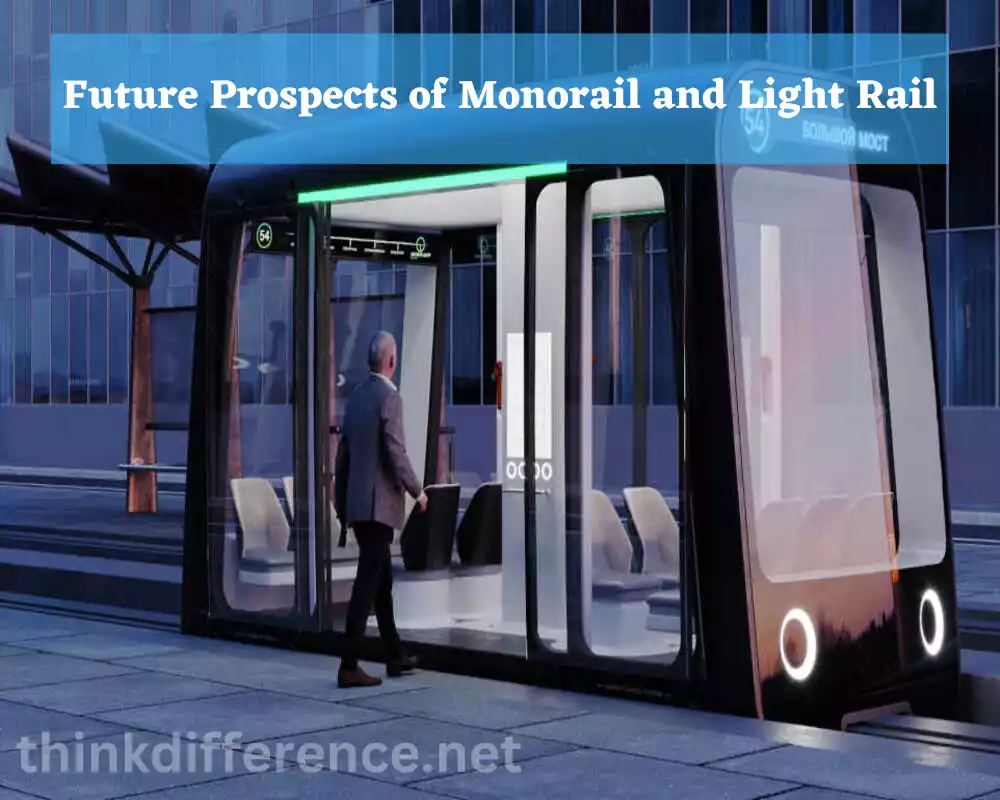
Here are some potential future prospects for both systems:
- Technological advancements: Both monorail and light rail systems are likely to benefit from ongoing technological advancements. These may include improved train control systems, advanced signaling and communication technologies, energy-efficient propulsion systems and innovative vehicle designs. Such advancements can enhance the performance, safety and passenger experience of both systems.
- Integration with smart city initiatives: The integration of monorail and light rail systems with smart city initiatives is a promising future prospect. This involves leveraging digital technologies, data analytics and connectivity to optimize operations, improve passenger flow and enhance overall transportation efficiency. Smart city initiatives facilitate seamless integration between various modes of transport such as trains, buses and ride sharing to provide travelers with convenient yet interlinked travel options.
- Renewable energy integration: The future of monorail and light rail systems may involve increased integration of renewable energy sources. This can include the use of solar panels along guideways or at stations to generate electricity for the systems. Batteries provide an effective means of storing extra energy and optimizing energy use, helping reduce fossil-fuel dependence while simultaneously cutting operating expenses for sustainable transportation solutions.
- Expansion and network growth: Many cities are expanding their public transportation networks to meet growing demand. Both monorail and light rail systems have the potential for network growth and expansion. Existing systems can be extended to cover new areas or connect with other transportation hubs, improving accessibility and connectivity within cities. Consider including monorail and light rail as part of their transportation infrastructure for optimal mobility and sustainable urban development.
- Improved passenger experience: Future developments in monorail and light rail systems are expected to focus on enhancing the passenger experience. Integration may involve adding features such as Wi-Fi connectivity, real-time passengers data systems, comfortable seating arrangements and accessibility features for those living with disabilities. Innovations in design, interior layout and onboard services can contribute to a more enjoyable and passenger-centric journey.
- Sustainable and resilient design: As cities prioritize sustainability and resilience, future monorail and light rail systems are likely to be designed with environmentally friendly and resilient features. This can include energy-efficient trains, use of eco-friendly materials in construction, integration with green spaces and urban green infrastructure, and design considerations for extreme weather events and climate change impacts.
It’s important to note that the future prospects of monorail and light rail systems will vary depending on the specific context, including local infrastructure, transportation demands, policy priorities and funding availability. The implementation and development of these systems require careful planning, stakeholder collaboration and consideration of local needs and constraints.
Conclusion
Monorail and Light rail systems offer sustainable and efficient solutions to the growing transportation needs of urban areas. Each system has its strengths and limitations, making them suitable for specific city layouts and requirements. As technology advances and more emphasis is placed on sustainable mobility, monorail and light rail will continue to play pivotal roles in shaping the future of urban transportation.

